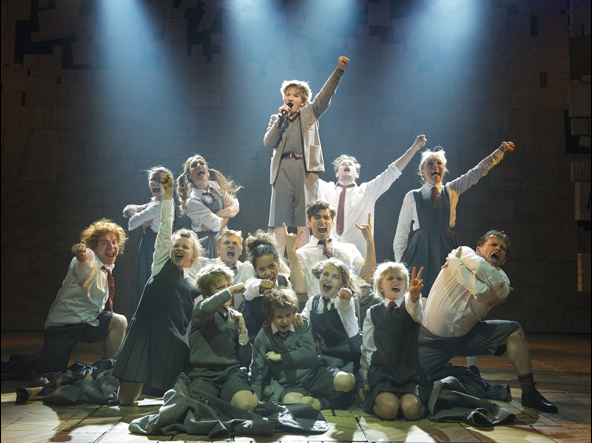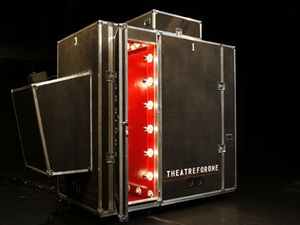The Huntington Theatre Company recently presented Yasmina Reza’s Tony and Olivier award winning play God of Carnage. This hilarious and often painful piece had a successful run at the Huntington, and I personally enjoyed it immensely. It is grounded enough in reality to allow the often outrageous, almost slapstick elements to feel true. Reza’s text gives us a nuanced look into what begins as an average evening with two sets of urban, upper-middle class parents that spirals horribly out of control. The Huntington’s production took this base and crafted an alternate universe, where everything is recognizable but no one is acting as they should.
God of Carnage is a classically-structured play. The three unities are observed: the play takes place in real time—about an hour and a half on the same evening, in one set—a Brooklyn living room, and with one plot—two couples meet to discuss and a fight between their two 11-year-old sons. Of course, things do not go as smoothly as hoped. Tension escalates slowly throughout the first part of the piece, coming to a head when the visiting mother, Annete Raleigh, gets sick and vomits all over the couch and coffee table. Once this bizarre event has transpired, the façade of social niceties has been broken. The characters start drinking--heavily, in some cases--and the conversation begins to focus more on the individual issues in the two marriages than on their children’s fight.
Before the evening progresses to borderline ridiculousness, it begins a calm, realistic way. This is one of the play’s greatest strengths. The characters feel like real people, not stereotypes or caricatures, and the situation and setting are immediately recognizable. This early grounding allows the audience to get swept along in the ridiculousness that ultimately ensues. A person who came in mid-way through would probably view the play as a farce, with over-the-top elements like a man crying over his cell phone and a woman lying drunkenly on someone else’s living room floor. When viewed in its entirety, though, as it is of course meant to be, the level of absurdity builds so slowly that it never actually feels absurd. The fact that Alan Raleigh is so obsessed and attached to his phone, for example, is established strongly enough in the beginning where we accept that seeing it ruined would reduce him to tears. Likewise, his wife does not get wasted in a few minutes time—we see her drink slowly at first, gaining speed as her anger grows until she is pounding shot after shot. The gradual build of absurdity is well handled both in the text and by the actors.
In addition to the truthful opening moments, the set and lighting helped keep the play grounded in reality. I have criticized the Huntington before for their overly-elaborate sets, but in this case, I feel it worked perfectly. The different levels and transparent walls around the staircases allowed the audience to see all the actors almost all the time, except when they went either up to the bathroom or down to the kitchen. This helped us stay in the world of the play. The levels also offered interesting blocking opportunities, of which director Daniel Goldstein took full advantage. The lights remained constant throughout the play until they dimmed at the end, when the actors remained in a tableau of desperation. Though lighting effects and changes can undoubtedly be used effectively to communicate shifts in tone, in this piece it was a good choice not to use them in this way. Keeping them constant maintained the piece’s realism; lights don’t dim or brighten to reflect mood in a real life living room. There is nothing meta-theatrical about the design of this production—it never reminds the audience that it is a play.
The only hint of meta-theatricality came in the opening moments of the play. I was not impressed by any of the actors at all early on—they all seemed stiff and rehearsed. It felt very clear that they were acting. As the action progressed, however, and the characters lost some of their inhibitions, the acting steadily improved as well. Looking back, I think it was an astute director’s choice to have the characters begin the play by consciously drawing attention to the fact that they were acting. Because, as we learn as the play progresses, they are all in fact acting different roles: perfect wife, perfect mother, etc. These roles were stripped away little by little, until the characters were bare and vulnerable on stage. By this point, the acting was naturalistic enough to not draw any attention to itself.
All the characters have major flaws, which is part of what makes them believable. I was able to sympathize with three of them in spite of their shortcomings. I felt that Michael Novak, however, is just an incredibly offensive and insensitive character. The way he would completely dismiss his wife’s thoughts and feelings made me despise him. This is unfortunately an all too familiar male character, and I think Reza wrote him in a disturbingly true way. Unfortunately people like this exist. He was just incredibly hard for me to watch. The other husband, who is constantly on his cell phone and clearly not an involved, supportive husband or father, still had some redeeming qualities for me. Both these men had elements frustrating believability.
I didn’t realize until I had a chance to read the program note after the performance that Reza is a French writer, and that God of Carnage was translated from French. Christopher Hampton, a playwright himself, should be applauded for capturing the bite of Reza’s text while still making the play sound decidedly American. In the program note, Rachel Carpman notes that though English-speaking audiences find Reza’s works to be farcical, apparently French audiences only “drily chuckle.” How one could meet onstage vomit with merely a dry chuckle is beyond me, but so be it. The audience at the Huntington found the play hilarious, even the parts not involving bodily fluids. After all the broad comedy throughout, however, the play ends on a serious, even tragic note. The Novak’s daughter calls, and Veronica has to pull herself together and deal calmly with the girl. She lies about a hamster which her husband had let loose outside the night before. It is a poignant note, and brings the drama back into focus: despite the fact that these characters have regressed to a state where they are behaving like children, ultimately they are adults who have a responsibility to care for actual children. The tragedy, then, is in the suggestion that life may have conditioned adults to act mature and put-together, but underneath we are all just as confused and lost as children.
Discussion of the hamster was a reoccurring motif. Michael got rid of the hamster the night before because its noise was bothering their some. Veronica and Annete both vilify him for what they view as essentially murdering the rodent. He defends himself by saying that not only was he allowing his son to rest by removing the irritating pet, he was setting it free. He claims he had thought it would happily run into the woods. Instead, however, the animal simply sat in the road and refused to move once it was dumped out of its cage. The hamster is a great stage metaphor, because it represents the situation of all the characters. Once they have been released from their cage of social normality, they no longer know how to function. We think of the rules of social behavior as something that we all mutually agree to, but Reza is arguing that maybe they are more a restraint than a positive choice. Underneath, perhaps we are all no more confident or put-together than a lost animal or angry child.




 Last week Ilana mentioned (or was it the week before?) a play being performed in Taxis for an audience of one or two people, which I thought was super cool, but I didn't realize until I heard this story that Intimate Theater was like a "thing"! I stumbled upon this article and adjoining audio story on npr.org that mentioned the "taxi theatre" in Melbourne, but also described dramas in offices, elevators, hotel rooms and theaters built just for two in Sydney, Edinburgh, New York and London. I think this is SO interesting. Audiences seemed to react positively to this type of theatre, saying the experience felt intimate and intense. One guy said he forgot he was watching an actor perform a monologue, and had the impulse to ask him questions about his story.
Last week Ilana mentioned (or was it the week before?) a play being performed in Taxis for an audience of one or two people, which I thought was super cool, but I didn't realize until I heard this story that Intimate Theater was like a "thing"! I stumbled upon this article and adjoining audio story on npr.org that mentioned the "taxi theatre" in Melbourne, but also described dramas in offices, elevators, hotel rooms and theaters built just for two in Sydney, Edinburgh, New York and London. I think this is SO interesting. Audiences seemed to react positively to this type of theatre, saying the experience felt intimate and intense. One guy said he forgot he was watching an actor perform a monologue, and had the impulse to ask him questions about his story.